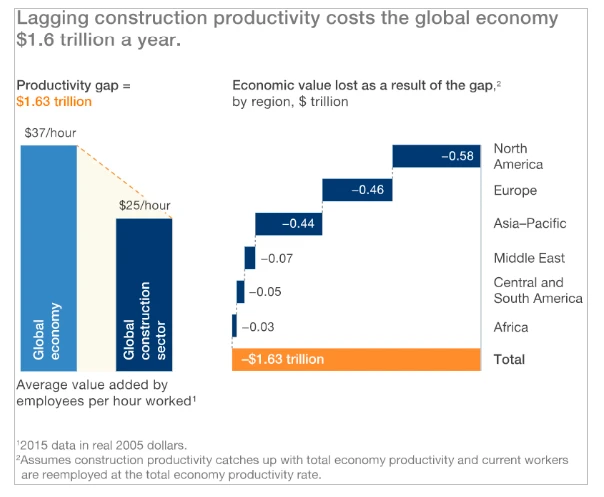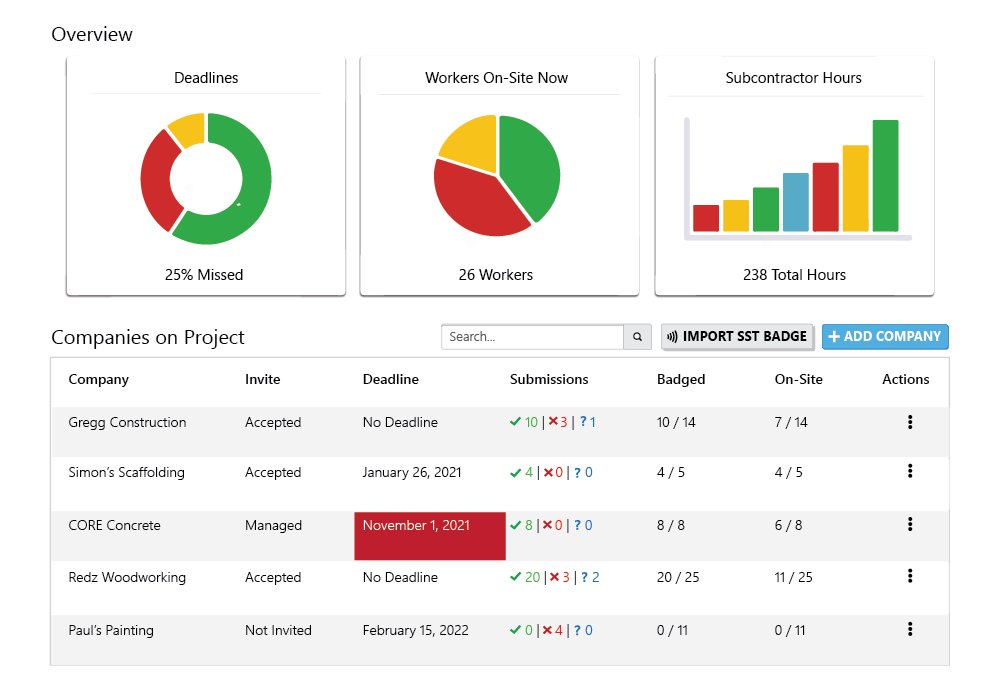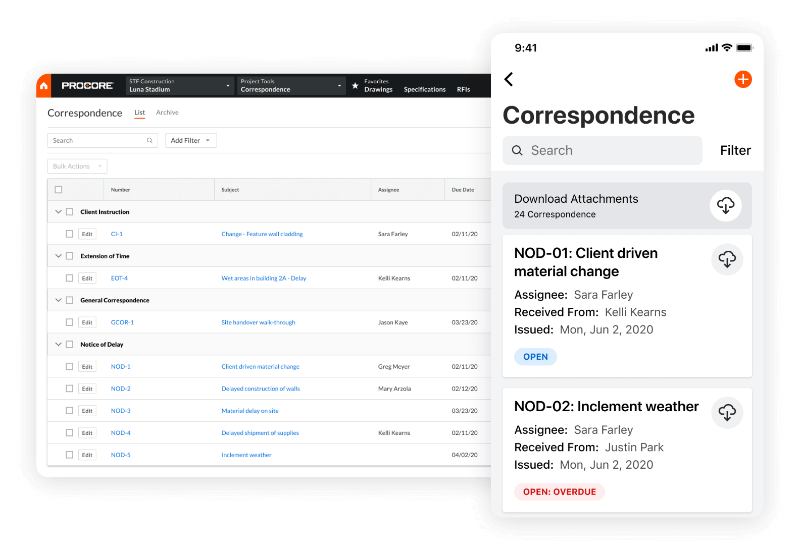Have you ever driven past a road construction crew and wondered how so many people can appear to be on break or not at work? Have you ever heard a construction worker complain about late materials deliveries? Or a machinist complaining about machine crashes or breakdowns? All these situations are examples of idle time, and all of this idle time illustrates clear productivity gaps and revenue growth opportunities.
This article will explore the different types of idle time, the cost of idle time, the idle time formula, an example of idle time, and detailed strategies that can be implemented to reduce idle time and drive productivity.
Table of Contents
What is Idle Time?
The Two Types of Idle Time
Normal Idle Time
Abnormal Idle Time
The Cost of Idle Time
Idle Time in Construction
More Idle Time = More Equipment Maintenance
The Idle Time Formula
Example of Idle Time in Construction
How to Reduce Idle Time
1. Optimize Workflows
2. Perform Preventative Asset Maintenance
3. Digitize Information and Communications
Conclusion
What is Idle Time?
Idle time is any time that an employee or machine spends at rest that could otherwise be used performing productive work activities. In other words, idle time is the sum of all paid, but unproductive labor time, and all unanticipated machine downtime or outages.
Key factors of idle time:
- Generally speaking, idle time refers to full-time employees of a company, not consultants.
- Idle time is a measure popularized in production-based industries, such as manufacturing and construction.
- Idle time can often be mitigated or reduced by better management practices and technological intervention.
The Two Types of Idle Time
Naturally, not all idle time can be eliminated, and not all idle time is inherently bad, with respect to the production process. Here are the two primary types of idle time and how they apply to both workers and machinery.
Normal Idle Time
Normal idle time is lost productivity that is necessary to ensure the health and safety of workers and the longevity of equipment and machinery that is vital to the production process.
Workers: time spent transitioning between task work, time spent setting up for work, time spent on breaks to avoid unnecessary fatigue, etc.
Machinery: regularly scheduled maintenance, regularly scheduled downtime, adjustments or programming of equipment, etc.
Abnormal Idle Time
Abnormal idle time is lost productivity that is not necessary to the production process and can be prevented by management or technological intervention.
Workers: idle time resulting from poor supervision, a failure to procure raw materials in a timely manner, strikes, lock-outs or any other preventable worker-related idle time.
Machinery: uncontrollable events such as power failures, machine breakdowns, natural disasters, or any other unforeseen events that make equipment and machinery unavailable for use.
The Cost of Idle Time
According to a 2018 Harvard Business School study, 78.1% of American workers experience idle time on a weekly basis. The summation of this idle time is estimated to cost employers over $100 billion a year. But it’s more than that.
Idle Time in Construction
The construction industry is widely recognized as one of the least productive sectors in the world. In fact, it costs the global economy 1.6 trillion dollars in lost value per year (16 times the total impact of idle time on the United States economy). These costs are made apparent by the 98% of megaprojects worldwide that experience cost overruns of greater than 30%, with 77% of them running more than 40% behind schedule.

Source: Mckinsey & Company
More Idle Time = More Equipment Maintenance
For example, maintenance costs in construction account for 10-30% of total project costs, depending on the types of machinery used. These costs are exacerbated when machinery is forced to run at idle. That’s because most engine-powered equipment, large or small, does not attain enough heat to guarantee proper combustion when forced to run at an idle pace. This causes greater oil contamination and leads to accelerated wear and tear on equipment. More wear and tear equals more downtime, more maintenance expense, and more idle worker time.
The Idle Time Formula
In a world without idle time, scheduled production time would equal actual production time. However, as we well know, this is rarely the case in industries such as construction and manufacturing. Therefore, the idle time formula is as follows:
Idle time = scheduled production time – actual productive time
Now, let’s break down these components a little further:
- Scheduled production time. The total time an asset was expected to be operational. For example, a construction worker might work (and be paid for) eight-hour shifts, making their scheduled production time, per day, equal to eight hours. Similarly, a piece of equipment (ex. a crane) might have an expected production time of eight-hours a day.
- Actual productive time. This is the total time that labor/equipment is actually contributing towards project goals. In the case of the worker, this is the portion of paid time that they spent directly performing work. In the case of the crane, this is the total time that the crane was utilized throughout the day.
- Idle time. Idle time arises when there are performance gaps caused by the inefficient deployment of labor and equipment.
Example of Idle Time in Construction
Let’s set the stage. We have a construction site in upper Manhattan where a 30-storey condo tower is in the early stages of construction. Today, we have a number of Subcontractors performing work on the site and one of those subcontractors is a crane operator.
Here are the details of the work contract with this specialty crane operator:
- There are two tower cranes on-site
- Each crane is being operated for 10-hours per day
- Each crane requires one crane operator
Idle time = scheduled production time – actual productive time
Operator idle time = (10 worker hours x 2) – actual productive time
Crane idle time = (10 crane hours x 2) – actual productive time
Now, consider that one of these crane operators arrives 15 minutes late for their shift. Then, a couple hours later, one of the cranes has a small technical malfunction and it is an hour before the operator is able to get the equipment back up and running again. Then, a scheduled materials delivery arrives an hour late that same afternoon, resulting in an hour of idle time for each operator and each crane.
Here is the impact on idle time:
Operator idle time = 20 hours – [20 – (0.25 hours – 1 hour – 2 hours)] = 16.75 hours
Crane idle time = 20 hours – [20 – (0.25 hours – 1 hour – 2 hours)] = 16.75 hours
In this scenario, the idle time of the worker and the equipment are directly correlated. Though this is not always the case, it is still very easy to see how small, yet often daily occurrences, can lead to massive productivity shortfalls on construction or manufacturing projects. And the more complex the production process, the greater the impact of idle time.
How to Reduce Idle Time
Normal idle time is unavoidable, but abnormal time can (and should) be targeted as a means of improving worker productivity, worker satisfaction, and company bottom line.
Here are some tactics for reducing idle time, specifically in the construction and manufacturing sectors.
1. Optimize Workflows
Though machine downtime and outages can be difficult to predict, most worker-related idle time is the direct result of inefficient project planning and process optimization. There are two ways that contractors can optimize their workflows; with manual process improvement, and with technology.
Some of the best tactics for optimizing workflows include:
- Create more balanced schedules. Look to reduce idle time by accounting for periods of machine idle. Simple changes, like slight scheduling overlaps can lead to greater equipment uptime and less time lost on shift transfer.
- Create clear operating procedures. Wherever possible, install systematic operating, reporting, and maintenance procedures that are easily repeatable. This will enhance the consistency and predictability of your operations.
- Practice the lean construction principles. Taking a lean approach to operations means identifying bottlenecks, implementing new processes, and refining your production process through continuous improvement.
Various construction technologies aim to assist contractors in optimizing their workflows. One of the best solutions for unlocking otherwise inaccessible workforce data is myComply. myComply’s access control integration makes it possible to mine more accurate time and attendance data and eliminate the effects of labor inflation. Automated reports save time when tracking worker details, certification summaries, orientation statuses, and overall project compliance reports.

Source: myComply’s Projects Pro
2. Perform Preventative Asset Maintenance
When it comes to preventing abnormal idle time dealt at the hand of equipment failures, one of the best practices to implement is preventative asset maintenance.
Here are some of the best tactics for maintaining your assets:
- Put important assets on a preventative maintenance plan. This is a systematic process of gathering information on the asset’s maintenance needs and history in order to create a maintenance plan that is broken down into daily, weekly, monthly, and yearly maintenance tasks that are executed by workers.
- Use equipment management software. Construction technology companies like Tenna allow you to protect your assets with intelligent asset monitoring tools. These asset trackers are built for a variety of different assets and allow contractors to track and report on asset movements, usage, wear, and more.
![]()
- Improve the quality of input materials. For example, if you are operating heavy equipment, investing in premium oil and fuel additives can be great way to prevent unnecessary equipment outages.
3. Digitize Information and Communications
Construction and manufacturing are two of the greatest laggards with respect to technological adoption and they are also the two industries that are impacted the greatest by idle time. This is no coincidence. Delays in communication and information transfer can be direct causes of idle time.
For example, if a change order is submitted and approved on a construction site, project management teams will have to communicate the implications of the order to each specialty contractor before they can resume work on the project. This creates idle time for project management as they traverse to each contractor. Once communicated and approved, idle time is also created within each subcontracting segment because work adjustments will likely need to be made, resulting in equipment changes, workforce adjustments, and more.
Project management solutions like Procore give contractors the power to communicate information instantly, via digital formats. This means less idle time and simpler correspondence between project teams, contractors, and project owners.

Source: Procore Project Management
Conclusion
The more idle time your firm has, the less productive your workforce is, the less able you will be to meet deadlines, and the less able you will be to make a significant profit (or any at all). Idle time is a plague, but it does not have to go untreated.
By implementing equipment monitoring technologies and processes, you can better anticipate maintenance needs. By digitizing documentations and implementing improved project management systems and processes, you can better identify, measure, and reduce the volume of idle time in your production process.
Interested in using myComply to track worker time and attendance, digitize orientations, manage worker certificates, and more? Book a demo with a product expert today to find out more.



